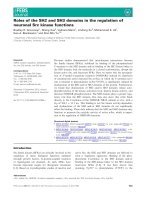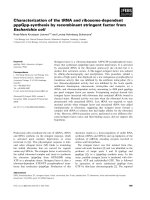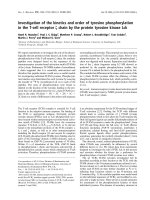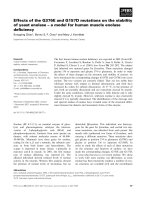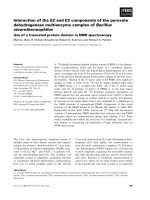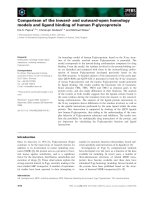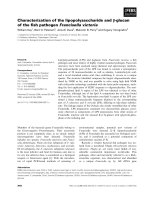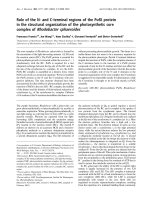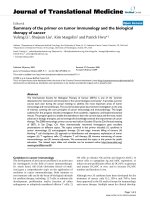Báo cáo hóa học: "EIGENVALUES OF THE p-LAPLACIAN AND DISCONJUGACY CRITERIA" docx
Bạn đang xem bản rút gọn của tài liệu. Xem và tải ngay bản đầy đủ của tài liệu tại đây (503.05 KB, 8 trang )
EIGENVALUES OF THE p-LAPLACIAN AND
DISCONJUGACY CRITERIA
PABLO L. DE NAPOLI AND JUAN P. PINASCO
Received 6 September 2005; Revised 6 March 2006; Accepted 15 March 2006
We derive oscillation and nonoscillation criteria for the one-dimensional p-Laplacian in
terms of an eigenvalue inequality for a mixed problem. We generalize the results obtained
in the linear case by Nehari and Willett, and the proof is based on a Picone-type identity.
Copyright © 2006 P. L. De Napoli and J. P. Pinasco. This is an open access article distrib-
uted under the Creative Commons Attribution License, which permits unrestricted use,
distribution, and reproduction in any medium, provided the original work is properly
cited.
1. Introduction
In this work we study the following equation:
|
u
|
p−2
u
+ q(t)|u|
p−2
u = 0. (1.1)
Here, 1 <p<
∞, t ∈ [a,+∞), and q(t) is a nonnegative continuous function not vanishing
in subintervals of the form (b,+
∞).
The solutions of (1.1) are classified as oscillatory or nonoscillatory. In the first case,
a solution has an infinite number of isolated zeros; in the second case, a solution has
a finite number of zeros. However, from the Sturm-Liouville theory for the p-laplacian
([11, 16, 22]; see also the recent monograph [10]) if one solution is oscillatory (resp.,
nonoscillatory), then every solution is oscillatory (resp., nonoscillatory). Hence, we may
speak about oscillatory or nonoscillatory equations, instead of solutions.
For the p-laplacian operator, there are several criteria for oscillation and nonoscilla-
tion in the literature; see for example [6–9]. Among the class of nonoscillatory equations,
when any solution has at most one zero in [a,+
∞), the equation is called disconjugate on
[a,+
∞).
The disconjugacy phenomenon is considerably more difficult and less understood
than nonoscillation; we refer the interested reader to the sur veys [3, 5, 23]forthelin-
ear case p
= 2.
Hindawi Publishing Corporation
Journal of Inequalities and Applications
Volume 2006, Article ID 37191, Pages 1–8
DOI 10.1155/JIA/2006/37191
2 Eigenvalues and disconjugacy
We consider first the disconjugacy problem on [a,+
∞). The relationship between dis-
conjugacy and the eigenvalues of a mixed problem
−u
= λq(t)u, u(a) = 0 = u
(b) (1.2)
is due to Nehari [17], and was generalized to different equations in [14, 20, 24]. We prove
here the following theorems generalizing some of their results for the p-laplacian.
Theorem 1.1. Let λ
1
be the first eigenvalue of
|
u
|
p−2
u
+ λq(t)|u|
p−2
u = 0, u(a) = 0 = u
(b), a<b, (1.3)
then (1.1)isdisconjugatein[a,+
∞) if and only if λ
1
> 1 for all b>a.
Also, we have the following result for oscillatory equations.
Theorem 1.2. Equation (1.1) is oscillatory if and only if there exists a sequence of intervals
[a
n
,b
n
] with a
n
<b
n
, a
n
+∞ as n +∞ such that the first eigenvalue λ
(n)
1
of
|
u
|
p−2
u
+ λq(t)|u|
p−2
u = 0, u
a
n
=
0 = u
b
n
(1.4)
satisfies λ
(n)
1
≤ 1 for n ≥ 1.
For the linear case p
= 2 and more general functions q(t), the proof in [23]followsby
analyzing a Lagrange identity formed by a positive solution of (1.1) and an eigenfunction,
and by using Riccati equation techniques. Our main tool for the proof of both theorems
is a Picone type identity as in [1, 13] and the variational characterization of the first
eigenvalue which can be obtained from the Rayleigh quotient (see [4, 12], and also [19]
for the equivalence between several abstract formulations),
λ
1
= inf
u∈W
b
a
|u
|
p
dt
b
a
q(t)|u|
p
dt
, (1.5)
where W
= W
1,p
0
(a,b) \{0} for the Dirichlet boundary condition, and W ={u ∈ W
1,p
(a,
b):u(a)
= 0}\{0} for the mixed problem (1.3).
As an application, we prove Leighton-Wintner theorem (see [7, 8]) for oscillation in
the half line.
Let us note that the eigenvalue problem for the p-laplacian has been widely studied in
recent years; see, for example, [2, 22] among several others, and the references therein.
Hence, a characterization for disconjugacy in terms of eigenvalues could be a useful tool.
Moreover, we also consider the disconjugacy phenomenon in a bounded closed inter-
val [a,b]. We will show that the existence of two zeros in [a,b]ofasolutionu is related
with the Dirichlet eigenvalue problem
−
|u
|
p−2
u
= λq(t)|u|
p−2
u, u(a) = 0 = u(b), (1.6)
and (1.1) is disconjugate if and only if the first eigenvalue satisfies λ
1
> 1. One implication
follows from the Sturmian comparison theorem.
P. L. De Napoli and J. P. Pinasco 3
Lemma 1.3. If ( 1.1)isdisconjugateon[a,b], then the first Dirichlet eigenvalue is greater
than one.
In order to prove the other implication, it is convenient to introduce the p-degree
functional
F(u;a,b)
=
b
a
|u
|
p
− q(t)|u|
p
dt (1.7)
which is positive for every u
∈ W
1,p
0
(a,b) not identically zero on (a,b)ifandonlyif(1.1)
is disconjugate on [a,b]. This equivalence can be found in the so-called Roundabout
theorem [8]. Hence, we have another equivalent criterion for disconjugacy on bounded
closed intervals.
As far as we know, this fact was not observed previously even for the linear case. There-
fore, the problem of finding disconjugacy conditions on finite intervals is related to the
problem of find lower bounds for eigenvalues. The search of lower bounds of eigenvalues
has a long history, which can be traced back to Sturm and Liouville; lower bounds for the
p-Laplacian eigenvalues were obtained in [18] by generalizing Lyapunov inequality [15],
a classical tool in oscillation theory.
The paper is organized as follows: in Section 2 we prove the main Theorems 1.1 and
1.2;inSection 3 we prove Lemma 1.3 and discuss its relationship with the Roundabout
theorem.
2. Main theorems
Our main tool is the following Picone-type identit y which can be found in [1].
Theorem 2.1. Let v>0, u
≥ 0 be differentiable a.e. in (a,b).Denote
L(u,v) =|u
|
p
+(p − 1)
u
p
v
p
|v
|
p
− p
u
p−1
v
p−1
|v
|
p−2
v
u
,
R(u,v)
=|u
|
p
−|v
|
p−2
v
u
p
v
p−1
.
(2.1)
Then,
(i) L(u,v)
= R(u, v),
(ii) L(u,v)
≥ 0 a.e. in (a, b),
(iii) L(u,v)
= 0 a.e. in (a, b) if and only if u = kv for some k ∈ R.
We are ready to prove The orems 1.1 and 1.2.
Proof of Theorem 1.1. Let us assume that (1.1)isdisconjugate,andletusprovethatλ
1
> 1.
To this end we suppose that λ
1
≤ 1 and first we will show that λ
1
< 1 is not possible in any
interval [a, b]. Then, if λ
1
= 1 for some interval, we will find a larger interval [a,c]such
that the corresponding first eigenvalue satisfies λ
(c)
1
< 1, a contradiction.
Hence, we suppose that there exist b>aand λ
≤ 1suchthatproblem(1.3)hasanon-
trivial eigenfunction u. Also, since (1.1) is disconjugate, there exists a positive solution v
of (1.1)on[a,+
∞). Then, v
(t) > 0on[a,+∞).
4 Eigenvalues and disconjugacy
From the definition of R(u,v)inTheorem 2.1,wehave
b
a
R(u,v)dt =
b
a
|u
|
p
dt −
b
a
|v
|
p−2
v
u
p
v
p−1
dt. (2.2)
Now, we use the weak formulation of Problems (1.1)and(1.3), multiplying the first
by
u
p
/v
p−1
and the second by u, obtaining
b
a
R(u,v)dt + |v
(b)|
p−2
v
(b)
u
p
(b)
v
p−1
(b)
= (λ − 1)
b
a
q(t)|u|
p
dt. (2.3)
Since R(u,v)
= L(u, v) ≥ 0, and we assume that λ ≤ 1, we have λ = 1.
Let us take c>b, and let us consider the eigenvalue problem in (a,c):
|
w
|
p−2
w
+ λq(t)|w|
p−2
w = 0, w(a) = 0 = w
(c). (2.4)
We extend the eigenfunction u as u(b)in(b,c), and let us call it
u.Sinceu is an admis-
sible function in the variational characterization of the first eigenvalue λ
(c)
1
in (a,c), we
obtain
λ
(c)
1
= inf
w∈W
1,p
(a,c),w(a)=0
c
a
|w
|
p
dt
c
a
q(t)|w|
p
dt
≤
c
a
|u
|
p
dt
c
a
q(t)|u|
p
dt
=
b
a
|u
|
p
dt
b
a
q(t)|u|
p
dt +
c
b
q(t)u
p
(b)dt
.
(2.5)
Let us observe that λ
(c)
1
< 1 unless q(t) ≡ 0in(b,c). Since this argument is valid for
each c>b,andq(t) cannot vanish identically on intervals of the form (b,+
∞), there
exists an interval (a,c) where the first eigenvalue satisfies λ
(c)
1
< 1, which is not possible by
the previous argument.
Let us prove now the converse. Let us assume that the first eigenvalue λ
1
of
|
u
|
p−2
u
+ λq(t)|u|
p−2
u = 0, u(a) = 0 = u
(b), a<b (2.6)
is greater than 1. If (1.1) is not disconjugate in [a,+
∞), there exists a solution v with two
zeros t
1
,t
2
∈ [a,+∞). Now, we choose v as a test function for the eigenvalue problem in
[a,t
2
], extending it by zero in [a,t
1
). Clearly, the Rayleigh quotient gives
λ
1
= inf
u∈W
1,p
(a,b),u(a)=0
b
a
|u
|
p
dt
b
a
q(t)|u|
p
dt
≤
t
2
t
1
|v
|
p
dt
t
2
t
1
q(t)|v|
p
dt
= 1, (2.7)
a contradiction. Hence, (1.1) must be disconjugate.
Proof of Theorem 1.2. Letusassumefirstthat(1.1) is oscillatory. Therefore, there exists
asolutionv with infinitely many zeros a<t
1
<t
2
< +∞.Letuschoosea
n
= t
n
, b
n
=
t
n+1
. The first Dirichlet eigenfunction in [a
n
,b
n
] coincides with v up to a multiplicative
constant, with eigenvalue equal to 1. The eigenvalue λ
(n)
1
of
|
u
|
p−2
u
+ λq(t)|u|
p−2
u = 0, u
a
n
=
0 = u
b
n
(2.8)
P. L. De Napoli and J. P. Pinasco 5
satisfies λ
(n)
1
≤ 1, since v is an admissible function in the variational characterization of it,
and
λ
(n)
1
= inf
u∈W
1,p
(a
n
,b
n
),u(a
n
)=0
b
n
a
n
|u
|
p
dt
b
n
a
n
q(t)|u|
p
dt
≤
b
n
a
n
|v
|
p
dt
b
n
a
n
q(t)|v|
p
dt
= 1. (2.9)
Suppose now that the eigenvalue condition is satisfied for a family of intervals [a
n
,b
n
].
Let us suppose that there exists a nonoscillatory solution u, and let us take one of the in-
tervals with a
N
greater than the last zero of u. Therefore, (1.1) is disconjugate in [a
N
,+∞)
(if not, there exists a solution with two zeros, and the Sturmian theory implies that u
must have a zero be tween them). Hence, from Theorem 1.1 we get λ
(N)
1
> 1, a contradic-
tion.
From Theorem 1.2 we have the following classical oscillation result.
Theorem 2.2 (Leighton-Wintner theorem). If
+∞
a
q(t)dt = +∞,then(1.1)isoscillatory
on [a,+
∞).
Proof. T he proof follows from Theorem 1.2.Foranya
n
≥ a,wechooseb
n
such that
b
n
a
n
+1
q(t)dt ≥ 1 (2.10)
and we compute the Rayleigh quotient for the first eigenvalue λ
(n)
1
of the mixed problem
|
u
|
p−2
u
+ λq(t)|u|
p−2
u = 0, u
a
n
=
0 = u
b
n
(2.11)
with the test function
v
=
⎧
⎨
⎩
t − a
n
if t ∈
a
n
,a
n
+1
,
1ift
∈
a
n
+1,b
n
.
(2.12)
Hence,
λ
(n)
1
= inf
u∈W
1,p
(a
n
,b
n
),u(a
n
)=0
b
n
a
n
|u
|
p
dt
b
n
a
n
q(t)|u|
p
dt
≤
b
n
a
n
|v
|
p
dt
b
n
a
n
q(t)|v|
p
dt
< 1. (2.13)
Remark 2.3. Adifferent proof of this theorem can be found in [10], without sign condi-
tion on q(t).
3. Disconjugacy on bounded intervals
In this section we consider the disconjugacy problem on a bounded closed i nterval. We
prove first Lemma 1.3.
Proof of Lemma 1.3. Let us suppose that the first eigenvalue λ
1
of
|
u
|
p−2
u
+ λq(t)|u|
p−2
u = 0, u(a) = 0 = u(b) (3.1)
satisfies λ
1
≤ 1.
6 Eigenvalues and disconjugacy
If λ
1
= 1, the corresponding eigenfunction u satisfies u(a) = 0 = u(b). Therefore (1.1)
is not disconjugate.
If λ
1
< 1, let us consider the unique solution u of
|
u
|
p−2
u
+ q(t)|u|
p−2
u = 0 (3.2)
satisfying
u(a)
= 0, u
(a) = 1. (3.3)
From the Sturmian oscillation theory, we conclude that u has a zero c between a and b,
and (1.1) is not disconjugate.
Now we state the Roundabout theorem. Lemma 1.3 proves (i)⇒(v); we will prove only
(v)
⇒(iv).
Theorem 3.1 (Roundabout theorem). Let q(t)
≥ 0, q(t) = 0 on [a,b]. The following state-
ments are equivalent.
(i) Equation (1.1)isdisconjugateonanintervalI
= [a,b]; that is, any nontrivial solu-
tion of (1.1)hasatmostonezeroinI.
(ii) There exists a solution of (1.1)havingnozeroin[a,b].
(iii) There exists a solution w of the generalized Riccati equation corresponding to (1.1),
w
+ q(t)+(p − 1)|w|
p
= 0, p
=
p
p − 1
, (3.4)
whichisdefinedonthewholeinterval[a,b].
(iv) The p-degree functional
F(u;a,b)
=
b
a
|u
|
p
− q(t)|u|
p
dt (3.5)
is positive for every u
∈ W
1,p
0
(a,b), u not identically zero on I.
(v) The first eigenvalue λ
1
of
|
u
|
p−2
u
+ λq(t)|u|
p−2
u = 0, u(a) = 0 = u(b) (3.6)
satisfies λ
1
> 1.
Proof. From the variat ional characterization of the first eigenvalue,
λ
1
= inf
u∈W
1,p
0
(a,b)
b
a
|u
|
p
dt
b
a
q(t)|u|
p
dt
. (3.7)
Hence, if λ
1
> 1, we have that
b
a
|u
|
p
dt −
b
a
q(t)|u|
p
dt ≥
λ
1
− 1
b
a
q(t)|u|
p
dt > 0 (3.8)
for every u
∈ W
1,p
0
(a,b), u = 0.
P. L. De Napoli and J. P. Pinasco 7
Remark 3.2. The eigenvalue problem in unbounded intervals was studied in [21]. How-
ever, it is not known if the eigenvalues can be characterized variationally.
Acknowledgments
We want to thank the referees for several comments improving the manuscript. The first
author is supported by Fundacion Antorchas and CONICET. The second author is sup-
ported by Fundacion Antorchas and ANPCyT under Grant PICT 03-05009.
References
[1] W.AllegrettoandY.X.Huang,A Picone’s identity for the p-Laplacian and applications, Nonlinear
Analysis. Theory, Methods & Applications 32 (1998), no. 7, 819–830.
[2] A. Anane, O. Chakrone, and M. Moussa, Spectrum of one dimensional p-Laplacian operator with
indefinite weight, Electronic Journal of Qualitative Theory of Differential Equations 2002 (2002),
no. 17, 1–11.
[3] J. H. Barrett, Oscillation theory of ordinary linear differential equations, Advances in Mathematics
3 (1969), no. 4, 415–509.
[4] F. E. B rowder, Infinite dimensional manifolds and non-linear elliptic eigenvalue problems, Annals
of Mathematics. Second Series 82 (1965), no. 3, 459–477.
[5] W. A. Coppel, Disconjugacy, Lecture Notes in Mathematics, vol. 220, Springer, Berlin, 1971.
[6] M. del Pino, M. Elgueta, and R. Man
´
asevich, Generalizing Hartman’s oscillation result for
(
|x
|
p−2
x
)
+ c(t)|x|
p−2
x = 0, p>1, Houston Journal of Mathematics 17 (1991), no. 1, 63–70.
[7] M. del Pino and R. Man
´
asevich, Oscillation and nonoscillation for (
|u
|
p−2
u
)
+ a(t)|u|
p−2
u =
0, p>1, Houston Journal of Mathematics 14 (1988), no. 2, 173–177.
[8] O. Do
ˇ
sl
´
y, Qualitative theory of half-linear second order differential equations, Mathematica Bo-
hemica 127 (2002), no. 2, 181–195.
[9] O. Do
ˇ
sl
´
yandS.Pe
˜
na, A linearization method in oscillation theory of half-linear second-order dif-
ferential equations, Journal of Inequalities and Applications 2005 (2005), no. 5, 535–545.
[10] O. Do
ˇ
sl
´
yandP.
ˇ
Reh
´
ak, Half-Linear Differential Equations, Elsevier, Amsterdam, 2005.
[11]
´
A. Elbert, Oscillation and nonoscillation theorems for some nonlinear ordinary differential equa-
tions, Ordinary and Partial Differential Equations (Dundee, 1982), Lecture Notes in Math.,
vol. 964, Springer, Berlin, 1982, pp. 187–212.
[12] S. Fu
ˇ
c
´
ık and J. Ne
ˇ
cas, Ljusternik-Schnirelmann theorem and nonlinear eigenvalue problems,Math-
ematische Nachrichten 53 (1972), 277–289.
[13] J. Jaro
ˇ
s, K. Taka
ˆ
si, and N. Yoshida, Picone-t ype inequalities for nonlinear elliptic equations and
their applications, Journal of Inequalities and Applications 6 (2001), no. 4, 387–404.
[14] W. Kim, Disconjugacy and comparison theorems for se cond order linear systems,SIAMJournalon
Mathematical Analysis 354 (2002), 4751–4767.
[15] A. Liapounov, Probl
`
eme G
´
en
´
eral de la Stabilit
´
e du Mouvement, Annals of Mathematics Studies,
vol. 17, Princeton University Press, New Jersey, 1949, reprinted from Annales de la Facult
´
edes
Sciences de Toulouse 9 (1907), 203–474, translation of original paper published in Communi-
cations of the Society of Mathematics, Kharkow (1892).
[16] J. D. Mirzov, On some analogs of Sturm’s and Kneser’s theorems for nonlinear systems
,Journalof
Mathematical Analysis and Applications 53 (1976), no. 2, 418–425.
[17] Z. Nehari, Oscillation criteria for second-order linear differential equations, Transactions of the
American Mathematical Society 85 (1957), no. 2, 428–445.
8 Eigenvalues and disconjugacy
[18] J. P. Pinasco, Lower bounds for eigenvalues of the one-dimensional p-Laplacian, Abstract and Ap-
plied Analysis 2004 (2004), no. 2, 147–153.
[19] R. C. Riddell, Nonlinear eigenvalue problems and spherical fibrations of Banach spaces,Journalof
Functional Analysis 18 (1975), no. 3, 213–270.
[20] K. D. Shere, Nonoscillation of second-order, linear differential equations with retarded argument,
Journal of Mathematical Analysis and Applications 41 (1973), no. 2, 293–299.
[21] K. Taka
ˆ
si and M. Naito, On the number of zeros of nonoscillatory solutions to half-linear ordinar y
differential equations involving a parameter, Transactions of the American Mathematical Society
354 (2002), no. 12, 4751–4767.
[22] W. Walter, Sturm-Liouville theory for the radial Δ
p
-operator, Mathematische Zeitschrift 227
(1998), no. 1, 175–185.
[23] D. Willett, Classification of second order linear differential equations with respect to oscillation,
Advances in Mathematics 3 (1969), no. 4, 594–623.
[24] N. Yoshida, Nonoscillation of elliptic differential equations of second order, Hiroshima Mathemat-
ical Journal 4 (1974), 279–284.
Pablo L. De Napoli: Departamento de Matematica, FCEyN, Universidad de Buenos Aires,
Ciudad Universitaria, Pabellon I, 1428 Buenos Aires, Argentina
E-mail address:
Juan P. Pinasco: Instituto de Ciencias, Universidad Nacional de General Sarmiento,
J.M. Gutierrez 1150, Los Polvorines, 1613 Buenos Aires, Argentina
E-mail addresses: ;
